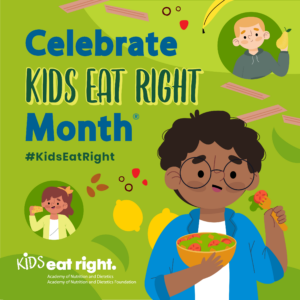August Is Kids Eat Right Month
go.ncsu.edu/readext?950177
en Español / em Português
El inglés es el idioma de control de esta página. En la medida en que haya algún conflicto entre la traducción al inglés y la traducción, el inglés prevalece.
Al hacer clic en el enlace de traducción se activa un servicio de traducción gratuito para convertir la página al español. Al igual que con cualquier traducción por Internet, la conversión no es sensible al contexto y puede que no traduzca el texto en su significado original. NC State Extension no garantiza la exactitud del texto traducido. Por favor, tenga en cuenta que algunas aplicaciones y/o servicios pueden no funcionar como se espera cuando se traducen.
Português
Inglês é o idioma de controle desta página. Na medida que haja algum conflito entre o texto original em Inglês e a tradução, o Inglês prevalece.
Ao clicar no link de tradução, um serviço gratuito de tradução será ativado para converter a página para o Português. Como em qualquer tradução pela internet, a conversão não é sensivel ao contexto e pode não ocorrer a tradução para o significado orginal. O serviço de Extensão da Carolina do Norte (NC State Extension) não garante a exatidão do texto traduzido. Por favor, observe que algumas funções ou serviços podem não funcionar como esperado após a tradução.
English
English is the controlling language of this page. To the extent there is any conflict between the English text and the translation, English controls.
Clicking on the translation link activates a free translation service to convert the page to Spanish. As with any Internet translation, the conversion is not context-sensitive and may not translate the text to its original meaning. NC State Extension does not guarantee the accuracy of the translated text. Please note that some applications and/or services may not function as expected when translated.
Collapse ▲August is Kids Eat Right Month and the Academy of Nutrition and Dietetics and the Academy of Nutrition and Dietetics Foundation shares the following article:
The Academy of Nutrition and Dietetics and its Foundation say parents and caregivers can play a significant role in children’s nutrition and health by teaching kids about healthful foods, being good role models and making sure physical activity is incorporated into each day.
“School-age children can be challenging because they are becoming more independent and may start eating more meals away from the family,” says Amy Reed, registered dietitian nutritionist and Academy Spokesperson. “Take advantage of the time you are with them and include them in planning and preparing meals. Include the foods that they are less likely to choose when they are away from you, such as fruits, vegetables and whole grains.”
The Academy and its Foundation celebrate Kids Eat Right Month® in August, which is a perfect time to reevaluate your family’s eating and physical activity habits and take the following steps to make positive, healthful changes:
Shop Smart. To encourage healthful eating, get your children involved in selecting foods, such as fruits and vegetables, which will appear at the breakfast, lunch or dinner table. Plan your meals and create a shopping list before you go to the store.

Cook Healthy. Involve your child in the preparation of meals with age-appropriate tasks. They will learn about food and may even be curious enough to try new foods they helped prepare.
Eat Together. Gather around the table as a family to enjoy a wonderful meal and the opportunity to share the day’s experiences with one another. Family meals encourage healthy family relationships and good eating habits.
Create Healthful Habits. Serve as a role model to help your kids develop healthful habits. Fill half your plate with fruits and vegetables and divide the rest of your plate to include a grain, especially a type of whole grain, such as brown rice or whole wheat pasta and a lean protein such as cooked beans or grilled chicken. For beverages, children older than 2 should drink water along with low-fat or fat-free milk. Drinks and foods with added sugars should be avoided in children younger than 2 and limited for older children. Serve calcium-rich foods with meals and snacks, such as low-fat yogurt, cheese or fortified soy versions.
Get Moving. Aside from being a terrific way to spend time together, regular physical activity is vital to strengthen muscle and bones, promote a healthy body weight, develop social skills and build self-esteem. Preschool children are encouraged to be active throughout the day, and older children and adolescents ages 6 through 17 should have at least 60 minutes of moderate-to-vigorous physical activity daily, according to the U.S. Department of Health and Human Services’ Physical Activity Guidelines for Americans (2nd ed.).
Get Talking. Eating nutritious foods can sometimes be a challenge for kids, particularly if they are picky eaters, but experts say that a conversation can help. Talk to your children about the foods they enjoy and introduce them to new foods from a variety of cultures to expand all of your horizons.
Learn more at eatright.org/for-kids or consult a registered dietitian nutritionist in your area by visiting “Find a Nutrition Expert” at eatright.org/find-a-nutrition-expert.


